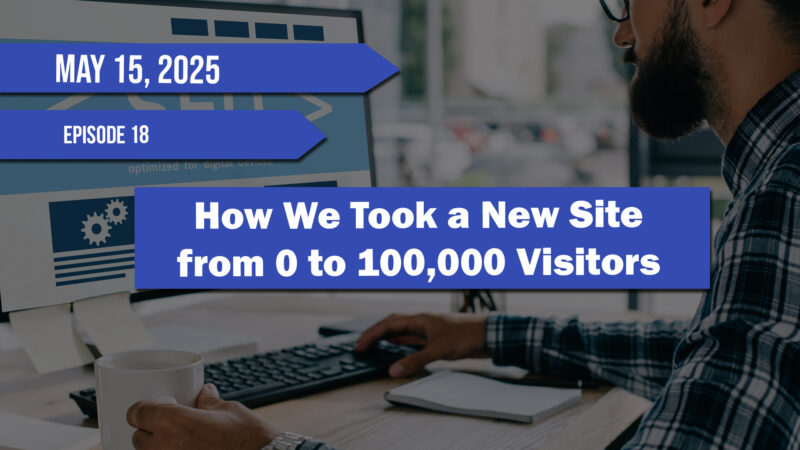Let’s talk about the reality behind going from zero traffic to 100,000 visitors. It’s not magic, it’s not luck, and it’s definitely not just “post more content and they will come.” I’m pulling back the curtain on a real-world SEO project where we took a brand-new site from absolutely nothing—no links, no authority, not even indexed—to hitting 100K visitors per month. This is what actually works, and what you should be focusing on if you’re serious about growth.
First, let’s get one thing straight: this wasn’t an overnight win. We’re talking months of strategic planning, execution, pivoting, and a relentless focus on value. But that’s the thing—SEO isn’t a slot machine. It’s not about pulling levers and praying. It’s about stacking smart decisions that compound over time.
Step 1: We Built for Speed and Structure First
Before a single word of content was published, we built the site like a performance machine. Clean code. Minimal plugins. Fast hosting. We stripped out every unnecessary script and element that could drag down load time.
Then we mapped out the entire content architecture. We didn’t guess. We ran a deep SERP analysis of the top players in the niche – looked at what they ranked for, how they structured their categories, how deep their topical coverage went.
We built a hub-and-spoke model from day one. That means pillar pages supported by dozens of internal articles, all strategically linked with keyword-rich anchors. We wanted Google to immediately understand the site’s topical relevance and hierarchy.
Step 2: Keyword Strategy That Actually Mattered
Here’s where most people screw up. They either chase keywords that are way too competitive out of the gate or they pick ultra-low volume stuff with no real intent behind it.
We went after the sweet spot – keywords with decent volume, low competition, and clear intent. We also focused heavily on informational queries at first because they’re easier to rank for and build topical authority fast. Think: “how to,” “best tools for,” “step-by-step” types of content.
But here’s the kicker – we weren’t just targeting keywords. We were targeting problems. Real pain points. Every article answered a specific question our target audience was actually asking.
Step 3: We Didn’t Just Write Content. We Built Assets.
I’m talking about posts that were 2,000 words minimum, with original graphics, videos, comparison tables, internal tools – you name it. These weren’t fluff articles designed to hit a word count. They were reference-level guides that made people bookmark the page, not bounce off it.
We wrote every article to outrank what was already on page one. Not just longer, but better – more actionable, more thorough, and more engaging.
Then we made sure every post linked to at least three other related pages on the site. Internal linking wasn’t an afterthought. It was a strategic play to build relevance and keep users (and crawlers) moving through the site.
Step 4: Link Building the Hard Way (But the Right Way)
No spam. No shady directories. No paid link schemes.
We built links by actually earning them.
We did manual outreach to niche bloggers and publications. We pitched guest posts that were actually useful, not just link dumps. We created free tools and data-driven studies that people wanted to cite. And we embedded CTAs to those assets right in our blog content.
We also leaned into HARO for high-authority mentions. That got us coverage on sites like Business Insider, local news outlets, and major tech blogs.
It wasn’t easy. But it was clean. And it built real authority that kept paying off with every new post we published.
Step 5: We Watched the Data Like Hawks
We lived inside Search Console, GA4, and Ahrefs.
Every month, we reviewed which pages were gaining traction, which keywords were shifting, and where users were dropping off. We updated underperforming content. We split-tested headlines. We trimmed content that wasn’t adding value.
We weren’t afraid to cut or consolidate. In fact, some of our biggest wins came from merging thin content into single, monster pages that instantly jumped in the rankings.
Step 6: We Made UX and CRO a Priority
Traffic is great. Conversions are better.
From month one, we treated every post like a landing page. Clear CTAs. Lead magnets. Simple, fast-loading design. We didn’t bombard users with popups, but we did give them clear next steps—whether that was joining an email list, downloading a guide, or clicking through to a product page.
And guess what? That early engagement fed right back into our SEO. More time on site. Lower bounce rates. Higher click-throughs from the SERP. Google noticed.
Final Thoughts
Going from zero to 100K visitors isn’t about chasing trends or hacking your way to traffic. It’s about doing the unsexy, consistent work—building value, being strategic, and thinking long-term.
If you’re trying to grow a new site, stop obsessing over vanity metrics and start thinking like an architect. Build something worth visiting, then make sure the right people can find it.
Because when you do that? Traffic follows. And so do conversions.

